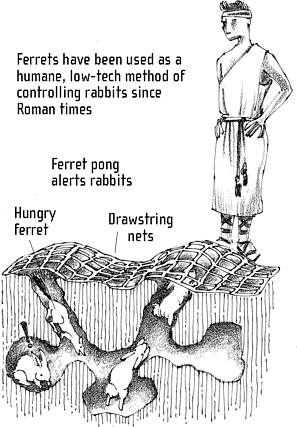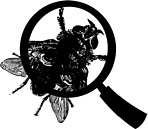The Book of Animal Ignorance (13 page)
Read The Book of Animal Ignorance Online
Authors: Ted Dewan
F
errets are the only member of the weasel family to have been domesticated and their popularity as pets is on the increase. On the face of it, this is surprising. Their scientific name,
Mustela putorius furo
, translates as âmusk-bearing stinking, thief', although most of this infamy is inherited. Ferrets are tame European polecats (from
poule chat
, âpoultry cat'), a creature so despised by farmers and gamekeepers that it was hunted, trapped and gassed to near-extinction across most of Britain during the nineteenth century. Also known as the âfoulmart' or âstinkmarten', the polecat was the scourge of hen-houses, but also helped keep the rabbit and mouse population in check. When they were originally domesticated, over 2,000 years ago, it was to exploit this natural aptitude.
Until the 1960s,
ferrets were used
to carry cable to
inaccessible areas
of Boeing aircraft
as they were being
built. They were
replaced, as they
often gave up and
fell asleep halfway
.
Polecats and ferrets continue to hybridise easily, and, ironically, it is the wild âpolecat' streak that makes the ferret a wonderful pet. Unlike dull, grass-chewing, social rodents, like hamsters and guinea pigs, the domestic ferret has remained a solitary hunter, as pure a carnivore as the domestic cat. But ferrets have none of the aloofness of cats: they are as curious, bold and responsive as puppies. You can teach a ferret to come to its name or take it for walks on a lead. The inquisitive streak that makes it lethal in a rabbit burrow is hugely diverting when it's âferreting' around in the backyard. One particular manoeuvre, the âwar dance', involves the ferret leaping backwards and sideways, chirping with excitement. They are particularly valued as pets by single professionals, as they sleep for eighteen hours, make hardly any noise, butare always ready with a cheerful fuss when you do return home.
CANNY CUNICULUS CATCHER

There are downsides. Despite keeping their quarters very clean, they do smell and even a well-looked-after ferret is probably a little too feral for indoors. Also, their natural high spirits mean they have little in the way of common sense. In a house they will disappear in holes in walls, behind doors, into cupboards, down the back of sofas and appliances like dishwashers, where they can get squashed. Nor do they have a homing instinct if they escape. Female ferrets (jills) can get sick if they aren't mated when in season. The simplest way is to keep a sterilised male (hoblet) to service them: an unfettered male (hob) might father fifteen kits a year. But be warned: ferret sex is nasty, brutish and long. The hob is much larger than the jill and has a penis shaped like a hockey stick that locks inside her for several hours, while he indulges in some fairly rough dragging and neck-biting. Rather like female cats, jill ferrets seem to need a measure of unpleasant foreplay before they release their eggs.
Ferrets also suffer from some very human ailments. Cancer of the lymphatic system and pancreas is relatively common, and they are prone to stress-related illnesses and bouts of depression, particularly if separated from a companion. Often they will refuse food, and mope for weeks. This makes them rather easier to empathise with than, say, a gerbil, and has led to their successfully deployment in âpet therapy'. An hour spent with a ferret seems to act as positive tonic for the elderly, the depressed, and children recovering from severe illnesses.
T
he malarial mosquito has claimed more human lives, but for Europeans at least, the horseman of the apocalypse rides a flea. None of the waves of bubonic plague that have swept Europe and Asia would have been possible without the odd personal habits of
Xenopsylla cheopis
, the Oriental rat flea. Like most of the 1,800 species included in the
Siphonaptera
order (âwingless siphons'), the rat flea is always hungry and not very fussy about where it eats. Plague starts in rodents (usually marmots) but is spread by the fleas that feed on them. Plague bacteria reproduces so quickly they block the flea's digestive passage. Very soon this produces a lot of hungry fleas, their mouthparts dripping with infected blood, ready to bite any mammal within striking distance, as more than a billion humans have found out to their cost.
Pet shops would be
bereft without fleas:
over $1 billion a year
are spent on anti-flea
products in the USA
alone. Pliny the Elder's
solution was cheaper:
collect the soil under
your right foot when
you hear the first
cuckoo of spring and
sprinkle it over them
.
Being unfussy gives fleas an advantage. Our very own species,
Pulex
irritans
, has largely been banished by better hygiene but can still be found on pigs. The fleas on your dog are probably cat fleas, as they are the most common and will live on most mammals or even a passing lizard. In fact, the only consistent requirement for fleas is that an animal sleeps in a den or nest. That's because fleas' eggs aren't attached to their host. They fall off, hatch and feast on the adult fleas' droppings. This is highly efficient: as a flea sucks its way through fifteen times its own body-weight in blood a day, its other end feeds the blind wormlike larvae. Once they pupate, the cocoons can lie dormant for a year, waiting for our vibrations to hatch them.
Streamlined to move effortlessly through hair, covered in
snaggable spines and combs, fleas are hard to remove and even harder to crush. Their legendary jumping skills aren't even dependent on muscle strength. Wingless, they have turned the wing-hinge structure into a mechanical spring made from a rubbery protein called resilin. This clicks shut as the body plates compress, like a catch on a jack-in-the-box. When released, it pushes down on the leg tendons, achieving an acceleration that is fifteen times that of a space-shuttle launching. The flea uses movement-sensitive hairs to calibrate precisely the distance and direction of its jump, and pumps air into special sacs in its legs to slow down before touchdown.
BUNNY LOVING

Impressive as this is, the real masterpiece of flea engineering is the penis. Proportionately the longest of any insect, it has so many hooks, springs and spines that it's been compared to a Swiss army knife. Unsurprisingly, it takes a long time to unfold, but then copulation can last for three hours â the equivalent of six weeks for a human. Adult fleas are ready for this marathon as soon as they emerge. No wonder a single pair of fleas can produce another 50,000 in a month, or that Carl Djerassi, the creator of the contraceptive pill for humans, also developed one for fleas.
F
lies are insects with two wings. Mayflies, dragonflies, fireflies and butterflies are not flies. There are 120,000 known species of true fly (almost 7,000 in the UK alone) between them carrying more than a million species of bacteria. The common housefly (
Musca domestica
) is among the most dangerous animals in the world. It breeds in rubbish, sewage and dung, and spreads tuberculosis, typhoid, cholera, dysentery, anthrax and parasitic worms by excreting, walking and vomiting on food.
Flies are prodigious breeders. In warm weather, the life-cycle from egg through maggot to adult lasts just eight to twelve days. Theoretically, two flies mating in April could produce 191,010,000,000,000,000,000 descendants by August: enough to cover the earth in a blanket of horridness 47 feet deep. But only a small proportion of flies are pests: most are essential for pollination and the recycling of decaying matter.
In Luoyang city in central China
the local authority is buying
dead flies off residents for 0.06
cents each to promote public
hygiene. This is reminiscent of
Mao's 1955 âfour harms'
campaign against flies, rats,
mosquitoes and sparrows. It
was stopped when the collapse
in the sparrow population led
to an explosion of crop-eating
insects
.
Flies have been much misunderstood throughout history. Arisotle confused the generations that followed him by implying flies had four legs and two âarms', and this was repeated in academic texts for more than a thousand years as no one bothered to look at a fly and check. Only in 1688 did the Italian biologist Francesco Redi disprove what everyone also believed: that maggots spontaneously generate from meat.
Flies land on the ceiling by zooming in close, reaching up with their front legs and flipping their whole body over
backwards. They walk around up there thanks to their sticky feet. These are covered in tiny hairs that produce a glue-like substance made of sugars and oils. They are also equipped with a pair of minute claws so they can detach themselves on departure.
MOPMOUTH

Of the flies that are pests, among the most serious are fruit flies: every year they cause billions of dollars of losses in fruit, vegetable and flower crops. Yet they are the most studied and the most fascinating flies of all. Cheap, easy to handle and quickly anaesthetised, it is easy to tell males from females and they breed extremely fast, so that many generations can be studied in a short time. The discovery of chromosomes, which won Thomas Hunt Morgan a Nobel Prize in 1933, stemmed from his work on fruit flies. It turns out that 61 per cent of human diseases have fruit-fly equivalents. Scientists who work on fruit-fly genes (known as drosophilists) like to give appropriate names to their more unusual discoveries. Flies with the âGroucho' gene have more face bristles than normal and âMaggies' have arrested development, like the baby in
The Simpsons
. Flies with the âKen and Barbie' gene have no external genitalia. This is a rare fruit-fly indeed. While the human sperm cell is the smallest in the body â it's only a 500th of an inch long â and a blue whale has sperm only a 5,000th of an inch longer than that â most male fruit-flies are real men. One species has sperm that is 2.3 inches in length â the longest in nature â and its testicles make up a whopping 11 per cent of its body-weight. That's proportionately larger than our heads. Fruit flies were the first animals in space and are still used by NASA today. They've come a long way since their four-legged ancestors of the Middle Ages.


